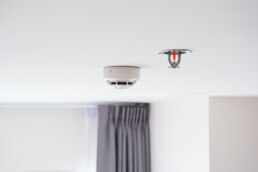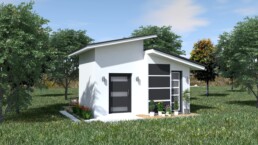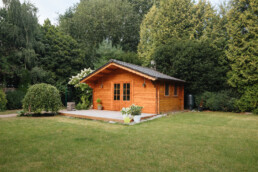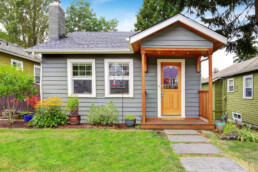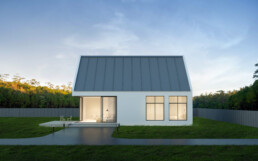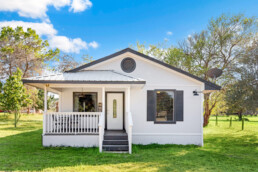Do ADUs in Marin County Require Fire Sprinklers?
Adding an Accessory Dwelling Unit (ADU) to your property in Marin County can be exciting. However, understanding the fire sprinkler requirements is crucial to ensure safety and compliance with local regulations.
Do ADUs in Marin County Require Fire Sprinklers?
In Marin County, the necessity for installing fire sprinklers in your ADU depends on specific conditions:
-
Primary Residence Sprinkler Status: If your main residence is equipped with a fire sprinkler system, your ADU will also need to have one. Conversely, if the primary dwelling lacks sprinklers, the ADU may not be required to have them.
-
Local Fire Authority Determination: The final decision rests with the local fire authority, such as the Marin County Fire Department or the Novato Fire Protection District. They assess each ADU project individually to determine if sprinklers are necessary. (nmwd.com)
Factors Influencing Fire Sprinkler Requirements
Several elements can influence the requirement for fire sprinklers in your ADU:
-
ADU Size and Use: Larger ADUs or those intended for specific uses may trigger the need for sprinklers.
-
Property Location: Properties situated in areas with higher fire risks might be subject to stricter regulations.
-
Access and Water Supply: Adequate access for firefighting and sufficient water supply are critical considerations.
Steps to Determine Your ADU's Fire Sprinkler Needs
To ensure compliance and safety:
-
Consult Local Fire Authorities: Engage with the Marin County Fire Department early in your planning process to understand specific requirements.
-
Review Marin County Fire Codes: Familiarize yourself with local fire codes, such as the Marin County Fire Code Ordinance, to grasp the regulations that may apply to your project. (marincounty.gov)
-
Collaborate with Professionals: Work with architects and contractors experienced in Marin County's ADU regulations to ensure your design meets all safety standards.
By proactively addressing these considerations, you can confidently navigate the requirements and create a safe, compliant ADU in Marin County.
Finding the Right ADU Contractor in Marin County: My Journey to Building a Dream Space
If you’re considering adding an Accessory Dwelling Unit (ADU) to your property, you’re probably feeling a mix of excitement and overwhelm. I’ve been there! When I started my own ADU project in Marin County, I quickly realized that finding the right ADU contractor was the most important decision I’d make. A great contractor can mean the difference between a smooth, stress-free build and a months-long nightmare.
After lots of research, consultations, and a bit of trial and error, I learned exactly what to look for in an ADU contractor in Marin County. If you’re embarking on your own ADU journey, here’s what you need to know to make the right choice.
Why Building an ADU in Marin County is a Smart Move
Before we dive into hiring a contractor, let’s talk about why building an ADU is such a fantastic investment:
- Rental Income – Renting out an ADU can generate passive income.
- Multi-Generational Living – ADUs make great housing for aging parents, adult children, or even a live-in caregiver.
- Property Value Boost – Homes with well-designed ADUs typically have higher resale values.
- More Affordable Than Moving – Instead of buying a bigger house, adding an ADU gives you extra space without the hassle of relocating.
Now, let’s get into the real challenge—finding a reliable, experienced ADU contractor in Marin County.
What to Look for in a Marin County ADU Contractor
Not all contractors are created equal, especially when it comes to building ADUs. The process is different from a traditional home remodel, so you need a contractor who knows local zoning laws, permit requirements, and cost-effective building methods.
1. Experience with ADUs
Many general contractors will take on an ADU project, but that doesn’t mean they specialize in them. ADUs come with unique challenges—small space design, utility connections, and ever-changing Marin County ADU regulations.
When I was searching, I made sure to ask:
✔ Have you built ADUs before?
✔ Can I see past projects?
✔ Do you understand Marin County’s ADU permit process?
If a contractor couldn’t answer these confidently, I moved on.
2. Knowledge of Marin County ADU Laws and Permits
One of the trickiest parts of building an ADU is getting through the permitting process. Marin County has specific rules about setbacks, parking requirements, and unit sizes. A contractor with local experience will help navigate this process and avoid costly delays.
Tip: Ask if they’ve worked in your specific city (San Rafael, Mill Valley, Novato, etc.), as some areas have additional restrictions.
3. Transparent Pricing & Detailed Contracts
I quickly learned that not all quotes are created equal. Some contractors give a low bid upfront but then hit you with “surprise” costs halfway through the project. Others might not include important things like site prep, utility hookups, or permit fees in the estimate.
A good ADU contractor in Marin County will:
- Provide a detailed, itemized estimate
- Explain what’s included (and what’s not)
- Be upfront about potential extra costs
If you get a vague, one-page bid that just says “Build ADU – $150,000,” run!
4. Strong Reviews & References
I spent hours reading online reviews before making a decision. Websites like Houzz, Yelp, and Google Reviews were great for seeing real customer experiences. But even better—talking to past clients directly.
Questions I asked references:
✔ Were there any delays or unexpected issues?
✔ Did the contractor stick to the budget?
✔ How was communication throughout the project?
My Experience: How I Found the Right ADU Contractor in Marin County
I won’t sugarcoat it—finding the right contractor took some time. I spoke with five different ADU builders before I found the one that felt like the perfect fit.
Here’s what helped me make my decision:
- They specialized in ADUs – Not just general home remodeling.
- They had great local reviews – Plus, I called past clients and got glowing recommendations.
- They understood Marin County’s unique building challenges – Like small lot sizes, fire safety codes, and historic preservation rules.
- They gave a detailed contract – No hidden fees or surprises.
Final Thoughts: Choosing Your ADU Contractor
If you’re serious about building an ADU in Marin County, don’t rush the contractor selection process. Take the time to interview multiple companies, ask tough questions, and trust your gut.
A great ADU contractor will make the process seamless, from design and permitting to construction and final inspection.
If you’re starting your ADU journey, I highly recommend working with a contractor who specializes in ADUs—it will save you time, money, and stress in the long run.
Good luck with your ADU project! If you have any questions about my experience, feel free to reach out.
Mill Valley ADU Laws: What to Know Before You Build
If you're a homeowner in Mill Valley, California, considering the addition of an Accessory Dwelling Unit (ADU) to your property, it's essential to familiarize yourself with the local regulations to ensure a smooth and compliant building process. ADUs, often referred to as granny flats or in-law units, offer a practical solution to housing shortages and can provide additional income or space for family members.
Understanding ADUs in Mill Valley
An ADU is a secondary housing unit on a single-family residential lot. These units can be detached, attached, or converted from existing spaces like garages or basements. Mill Valley also permits Junior Accessory Dwelling Units (JADUs), which are smaller units within the primary residence, typically not exceeding 500 square feet.
Key Regulations for ADUs in Mill Valley
- Size Limits:
- Detached ADUs: Can be up to 1,200 square feet.
- Attached ADUs: Cannot exceed 50% of the existing residence's floor area, with a maximum of 1,000 square feet. However, an ADU of up to 800 square feet is always allowed, regardless of other standards.
- JADUs: Limited to 500 square feet.
- Setbacks:
- Side and Rear: A minimum setback of 4 feet is required.
- Front: Must comply with the primary structure's setback requirements.
- Conversions: No additional setbacks are required when converting existing legal structures into an ADU.
- Height Restrictions:
- Detached ADUs: Limited to 16 feet in height.
- ADUs Above a Detached Garage: The combined height of the ADU and the garage shall not exceed 25 feet.
- Parking Requirements:
- One off-street parking space is required for each ADU, except when:
- The ADU is located within one-half mile walking distance of public transit.
- The ADU is entirely within a proposed or existing primary dwelling or other existing structure.
- The ADU is located within a historic district.
- On-street parking permits are required but not offered to the occupant of the ADU.
- There is a City-approved and dedicated parking space for a car share vehicle located within one block of the ADU.
- One off-street parking space is required for each ADU, except when:
- Owner Occupancy:
- There is no owner occupancy requirement for ADUs. However, JADUs require the property owner to reside on the property.
- Design Standards:
- ADUs must maintain the architectural style of the primary residence, ensuring consistency in design and materials.
Permitting Process for Mill Valley ADUs
Mill Valley offers a streamlined, ministerial approval process for ADUs up to 800 square feet, provided they meet specific criteria. This means that if your ADU project complies with the established standards, it can be approved without discretionary review, expediting the permitting process.
Benefits of Building an ADU in Mill Valley
- Rental Income: Generate additional income by renting out the unit.
- Housing Flexibility: Provide living space for family members or guests.
- Property Value: Increase the overall value of your property with additional living space.
Next Steps: Mill Valley ADU Laws
If you're considering building an ADU in Mill Valley:
- Consult the Mill Valley Planning Department: They can provide detailed information and guidance specific to your property.
- Review Local Ordinances: Familiarize yourself with Mill Valley's municipal code regarding ADUs to ensure compliance.
- Engage Professionals: Consider hiring architects or contractors experienced in ADU construction to assist with design and permitting.
By understanding and adhering to Mill Valley's ADU regulations, you can successfully add a valuable and functional space to your property.
San Rafael ADU Laws: What You Need to Know Before You Build
If you're a homeowner in San Rafael, California, considering adding an Accessory Dwelling Unit (ADU) to your property, it's essential to understand the local regulations to ensure a smooth and compliant building process. ADUs, often referred to as granny flats or in-law units, offer a practical solution to housing shortages and can provide additional income or space for family members.
Understanding ADUs in San Rafael
An ADU is a secondary housing unit on a single-family residential lot. These units can be detached, attached, or converted from existing spaces like garages or basements. San Rafael also permits Junior Accessory Dwelling Units (JADUs), which are smaller units within the primary residence, typically not exceeding 500 square feet.
Key Regulations for ADUs in San Rafael
- Size Limits:
- Detached ADUs: Can be up to 1,200 square feet.
- Attached ADUs: Cannot exceed 50% of the existing residence's floor area, with a maximum of 1,000 square feet. However, an ADU of up to 800 square feet is always allowed, regardless of other standards.
- JADUs: Limited to 500 square feet.
- Setbacks:
- Side and Rear: A minimum setback of 4 feet is required.
- Front: Must comply with the primary structure's setback requirements.
- Conversions: No additional setbacks are required when converting existing legal structures into an ADU.
- Height Restrictions:
- ADUs are generally limited to a height of 16 feet. However, depending on your residential zoning code, you may be able to build two stories.
- Parking Requirements:
- Generally, conversion ADUs and JADUs don’t require any parking. Attached and detached ADUs will require 1 parking space, unless your project qualifies for an exemption from the parking requirements.
- Owner Occupancy:
- There is no owner occupancy requirement for ADUs. However, JADUs require the property owner to reside on the property.
- Design Standards:
- ADUs must maintain the architectural style of the primary residence, ensuring consistency in design and materials.
Permitting Process for San Rafael ADUs
San Rafael offers a streamlined, ministerial approval process for ADUs up to 800 square feet, provided they meet specific criteria. This means that if your ADU project complies with the established standards, it can be approved without discretionary review, expediting the permitting process.
Benefits of Building an ADU in San Rafael
- Rental Income: Generate additional income by renting out the unit.
- Housing Flexibility: Provide living space for family members or guests.
- Property Value: Increase the overall value of your property with additional living space.
Next Steps: San Rafael ADU Laws
If you're considering building an ADU in San Rafael:
- Consult the San Rafael Planning Division: They can provide detailed information and guidance specific to your property.
- Review Local Ordinances: Familiarize yourself with San Rafael's municipal code regarding ADUs to ensure compliance.
- Engage Professionals: Consider hiring architects or contractors experienced in ADU construction to assist with design and permitting.
By understanding and adhering to San Rafael's ADU regulations, you can successfully add a valuable and functional space to your property.
Marin County ADU Laws: What You Need to Know Before You Build
Accessory Dwelling Units (ADUs) have become an increasingly popular way to add flexible living space, generate rental income, or provide housing for family members. But before you start building an ADU in Marin County, you need to understand the local ADU laws to ensure your project complies with zoning regulations, size limits, and permitting requirements.
If you're a homeowner in Marin County, here's what you need to know about ADU laws before you get started.
What is an ADU?
An Accessory Dwelling Unit (ADU) is a secondary residential unit that exists on the same lot as a primary home. ADUs can be detached, attached, or converted from an existing structure (such as a garage or basement).
Marin County also allows Junior ADUs (JADUs), which are smaller, self-contained units within the primary home. JADUs must be under 500 square feet and typically share a bathroom with the main residence.
Marin County ADU Laws: The Basics
If you're considering adding an ADU in Marin County, here are the key laws and regulations you need to be aware of:
1. Zoning and Eligibility
Most single-family and multi-family residential lots in Marin County are eligible for an ADU, but the exact requirements depend on your location.
- ADUs are permitted by right on most residential properties.
- Multi-family properties may be eligible for multiple ADUs (converted from non-livable spaces like basements or storage rooms).
- Check with your local city or town planning department, as some cities within Marin County have their own ADU rules.
2. Size and Height Limits
The size of your ADU depends on whether it is attached or detached:
- Detached ADUs: Maximum 1,200 square feet
- Attached ADUs: Cannot exceed 50% of the main home’s floor area, up to 1,000 square feet
- JADUs: Limited to 500 square feet
- Height Limit: Typically 16 feet, but taller structures may be allowed with additional approvals
3. Setbacks
- Side and rear yard setbacks: 4 feet minimum
- Front yard setback: Must match the primary home’s required setback
- No setback required when converting an existing structure (like a garage) into an ADU
4. Parking Requirements
One parking space is required for most ADUs unless your property qualifies for an exemption. Parking is not required if:
- The ADU is within half a mile of public transit (bus stop, ferry, or train station)
- The ADU is part of the primary residence (like a garage conversion)
- On-street parking permits are not required in your area
JADUs do not require any additional parking.
5. Owner-Occupancy Rules
- ADUs: As of recent California law updates, owner-occupancy is NOT required for new ADUs. This means you can rent out both the main home and the ADU.
- JADUs: The owner must live on-site in either the main house or the JADU.
6. Utility Connections and Impact Fees
- ADUs under 750 square feet are exempt from impact fees in Marin County.
- ADUs over 750 square feet may require separate utility connections and impact fees (varies by location).
- If converting a garage or basement, you may be able to share existing water and sewer connections.
7. Permitting Process
The good news? Many ADUs qualify for streamlined, ministerial approval, meaning they don’t require public hearings or special permits.
Steps to get started:
- Consult your local planning department – ADU regulations may vary by city.
- Prepare your ADU design and plans – Work with an architect or designer.
- Submit for permits – A building permit is required for all ADUs.
- Begin construction – Once permits are approved, you’re good to go!
Most permits are approved within 60 days, as long as the ADU meets Marin County’s requirements.
Why Build an ADU in Marin County?
Adding an ADU is a smart investment with multiple benefits:
✔ Rental Income – Generate passive income with a long-term rental or short-term lease.
✔ Family Housing – Provide housing for aging parents, adult children, or caregivers.
✔ Increased Property Value – Homes with ADUs often have higher resale values.
✔ Sustainable Housing – ADUs help create affordable housing solutions in Marin County.
Final Thoughts
Navigating Marin County ADU laws can seem complicated, but understanding the key requirements will help you plan your project with confidence. Whether you’re looking to build a rental unit, a guest house, or extra living space, an ADU is a great way to maximize your property’s potential.
If you're serious about building an ADU, make sure to consult with your local planning department to confirm specific regulations in your city or town. Each city in Marin County (such as San Rafael, Mill Valley, and Novato) may have slightly different ADU rules.
Want to make the ADU process even easier? Work with a team that specializes in Marin County ADU development to handle permits, designs, and construction.
Marin County ADU Requirements
If you're considering adding an Accessory Dwelling Unit (ADU) to your property in Marin County, California, it's essential to understand the local requirements to ensure a smooth and compliant building process. ADUs offer a fantastic opportunity to expand living space, generate rental income, or provide housing for family members. However, navigating the specific regulations in Marin County is crucial.
Types of ADUs in Marin County
Marin County recognizes several types of ADUs:
- Attached ADUs: These units are connected to the main residence and can be located at the back, side, or front of the house.
- Detached ADUs: Separate structures situated on the same property as the primary residence.
- Junior Accessory Dwelling Units (JADUs): Smaller units, often created by converting an existing bedroom within the main house. JADUs must have a kitchenette and can share a bathroom with the primary residence. They are limited to a maximum size of 500 square feet.
General Requirements
Understanding the general requirements for ADUs in Marin County is vital:
- Zoning: Properties zoned for single-family, two-family, or multifamily use may be eligible to build ADUs.
- Size Limits:
- Detached ADUs: Up to 1,200 square feet.
- Attached ADUs: Cannot exceed 50% of the existing residence's floor area.
- JADUs: Maximum of 500 square feet.
- Height Restrictions: Detached and attached ADUs can reach a height of 16 feet. For anything higher, it's advisable to consult with the county planning office.
- Setbacks: A minimum setback of 4 feet from side and rear lot lines is required for detached ADUs. Front setbacks should comply with the standards of the primary structure. No setback is required if converting a legal garage.
- Parking: One parking space is generally required for ADUs unless:
- The ADU is located within one-half mile walking distance of public transit.
- It's part of the proposed or existing primary residence or an accessory structure.
- On-street parking permits are required but not offered to the occupant of the ADU.
- There is a car share vehicle located within one block of the ADU.
- Owner Occupancy: Currently, there is no owner occupancy requirement for ADUs in Marin County. However, JADUs do require the property owner to reside on the property.
Permitting Process
The permitting process for ADUs in Marin County is designed to be straightforward:
- Ministerial Approval: Many ADUs can be approved ministerially, meaning they don't require discretionary review. This streamlines the process, allowing for quicker approvals.
- Building Permits: Regardless of the type of ADU, obtaining the necessary building permits is essential to ensure compliance with local building codes and safety standards.
Benefits of Building an ADU
Constructing an ADU in Marin County offers several advantages:
- Rental Income: Renting out an ADU can provide a steady source of income.
- Housing for Family Members: ADUs are ideal for housing elderly parents, adult children, or caregivers, allowing for proximity while maintaining privacy.
- Increased Property Value: Adding an ADU can enhance the overall value of your property by providing additional living space.

